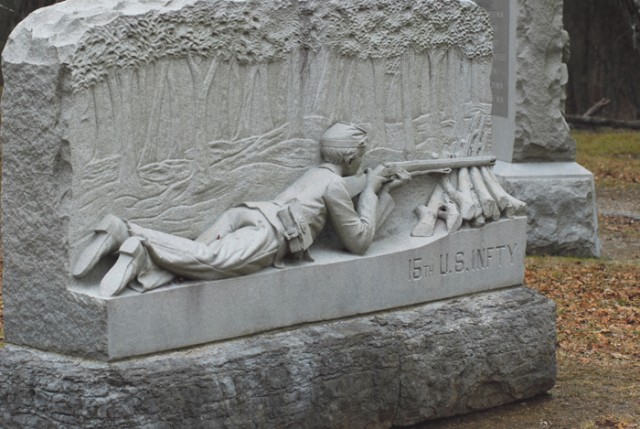FORT BENNING, Ga. - Soldiers with 1st Battalion, 15th Infantry Regiment, honored their predecessors Friday during a wreath-laying ceremony at Chickamauga and Chattanooga National Military Park.
The Soldiers, joined by veterans and 15th Infantry Regiment Association members, made the drive from Fort Benning to the park, located approximately 10 miles south of Chattanooga, Tenn., to commemorate the regiment\'s history.
Standing on the same battlefield where thousands of Union and Confederate troops died during the Civil War, the battalion's rear detachment learned the history of the 15th and retraced the footsteps of a battle considered by historians to be the most significant Union defeat in the western theater during the war.
The battalion is currently deployed with the 3rd Heavy Brigade Combat Team.
The Battle of Chickamauga was fought by the Union Army of the Cumberland and the Confederate Army of Tennessee Sept. 19-20, 1863, and marked the end of the Union offensive in southeastern Tennessee and northwestern Georgia. The Union Army, led by MG William Rosencrans, pushed the Confederates, led by GEN Braxton Bragg, south out of Chattanooga but Bragg hoped to regain the city by returning north and breaking the Union line. The two forces met at Chickamauga. After heavy losses on both sides, the Confederates were ultimately declared the victors as the Union Army retreated. The battle's namesake stems from the West Chickamauga Creek, which flows nearby. The number of casualties, more than 34,000, was the second highest in the war, following the Battle of Gettysburg, according to historical accounts.
"As the battle unfolded, the men who fought here realized something powerful, decisive, tragic, significant and instructive would happen in the war as a result of this battle," said Jim Ogden, National Park Service historian for the site.
Ogden led the Soldiers on a four-hour tour of the park, which encompasses 5,000 acres of the battlespace. The Soldiers traced the journey of the regiment, which fell under the Regular Brigade of the Union Army, on the final day of battle. The Soldiers learned how poor judgment, lack of sleep and inappropriate firepower for the environment they were in contributed to heavy losses for both sides and the defeat of the Union Army.
CPL Scott Peckham, the rear detachment's personnel NCO, said the biggest reason he would encourage his fellow Soldiers to visit the battlefield is for identity.
"When recruiters ask why you want to join the Army, a lot of people say they want something to belong to," Peckham said. "There is pride in knowing our battalion's history."
SGT Isaac LaBelle, a gunner with B Company, 1st Battalion, said he found following in the footsteps of his forefathers encouraging.
"Seeing how we fought in the war and the struggles they went through, their hardships were a lot more than I've had to endure," said LaBelle, who is on leave from the battalion's deployment to attend Ranger School.
"We were standing on the same ground where others fought, died and were heroic," said CPT Andrew Lerch, the rear detachment's commander. "This tour has shown us that the principles of war employed during the Civil War are still relevant today - we can tie them to situations in today's conflict."
Fast facts about 1st Battalion:
- The battalion is known as the "Audie Murphy" battalion for its most famous member. Murphy received the Congressional Medal of Honor and was the most decorated combat Soldier of World War II. He was a member of and briefly commanded B Company.
- The "Rock of Chickamauga," which appears on the battalion's unit crest, refers to MG George Thomas, the Union officer who fought to maintain the Army's position during the battle, while his commander and peers fled, until ordered to withdraw.
- The four acorns on the battalion's insignia stand for the four major engagements of the 15th Infantry Regiment during the Civil War: The battles of Murfreesboro, Chickamauga, Chattanooga and Atlanta.






Social Sharing